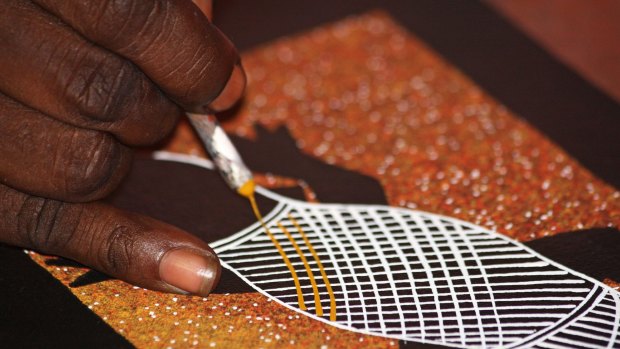This was published 8 years ago
Ayers Rock Resort, Northern Territory, Australia: Free indigenous-themed activities on offer

Aboriginal art, close up.Credit: Alamy
Indigenous artist Sarah Dalby sits cross-legged next to the Maruku Arts stall at Ayers Rock Resort. It's late May – rain drenched the desert the previous day but now the sun's back out. She's finishing a canvas and chatting to a fellow artist while two Japanese women watch her every move. As Dalby places her final mark, in the canvas's centre, the women applaud. The artist glances up, breaking into a huge grin. This type of moment that crosses language barriers has become commonplace as the resort has found more ways for guests and Indigenous people to interact.
The change at the resort came in 2010 when it was bought by the Indigenous Land Corporation (ILC) – a Federal entity that acquires and manages land to benefit Indigenous Australians. At the time, the resort had only two Indigenous employees; today there are about 250 (a third of the workforce) thanks largely to the establishment of a training academy at Yulara.
Guests can tap into free Indigenous-themed activities, such as learning which plants around the resort are good for food and medicine, throwing a boomerang and spear, or sitting in a circle on the Town Square lawn to hear a few yarns. There are also paid activities such as dot-painting workshops with artists like Sarah, who also stars in Tourism Australia's new campaign.
Voyages Indigenous Tourism Australia manages Ayers Rock Resort (and Mossman Gorge Centre) on the ILC's behalf - both ventures are Indigenous tourism champions. The resort's evolution continues, says Andrew Williams, Voyages' chief executive, with the recent opening of Wintjiri Arts & Museum to showcase central desert art and artists.
Guests can watch artists from outlying communities at work in the new space (in addition to seeing them working near the Maruku stall). It's also added a bush tucker "trail" through the restaurants, with Indigenous ingredients featuring across all menus. Last month saw another change with the departure of the Wakagetti dance troupe. The resort is now working with the local community to develop new content.
Williams says the changing face of the resort's workforce has "brought a real energy to the place". "It's motivating for non-Indigenous staff also to be part of something that's making such a difference and really building an Indigenous workforce for the Australian tourism industry," he says.
The main shopfront for Anangu-owned, not-for-profit Maruku Arts (another Indigenous tourism champion) is at the cultural centre in Uluru-Kata Tjuta National Park. When I visit, gallery manager Michael Heuer is run off his feet: today it seems everyone wants a painting or a punu (carvings of desert animals such as perentie lizards and sand goannas with designs burnt into the timber). Maruku represents up to 1000 artists from 22 communities spread over 407,000 square kilometres.
After living in the area for 15 years, Heuer has noted a massive change in visitors' interests. "The focus used to be on climbing [Uluru] and there wasn't a lot of push on actually enjoying the culture, which is what the place is all about," he says. "Now people have a better understanding."
The writer was a guest of Ayers Rock Resort. See ayersrockresort.com.au, maruku.com.au.
Sign up for the Traveller Deals newsletter
Get exclusive travel deals delivered straight to your inbox. Sign up now.